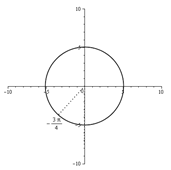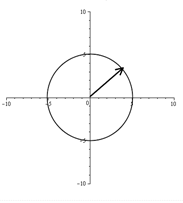
Plot the point in the polar coordinates and find three additional polar representations.
Answer to Problem 18E
Additional polar representations are
Explanation of Solution
Given:
Consider the polar coordinate as:
So, the directed distance from origin is:
Also, the directed angle is:
Convert this into pi radian as:
Now, draw this polar coordinate in xy-plane as below. First consider the angle. So, as the angle is negative, so the count of angle will be clockwise. So, the considered angle will be as below:

Now,the directed distance is −5. So, for the negative sign the

Now, find the two additional polar representations of the points
So, consider the positive angle. But, the angle is clockwise. So, the directed angle will be:
Convert into radian as:
Now, angle is positive and the plot is clockwise. So, the value of r is negative. So, the directed distance is:
So, the polar coordinate is :
So, consider the positive angle. So, the angle will be anticlockwise. So, the directed angle will be:
Convert into radian as:
Now, angle is positive and the plot is anticlockwise. So, the value of r is positive. So, the directed distance is:
So, the polar coordinate is:
Chapter 10 Solutions
EBK PRECALCULUS W/LIMITS
- (10 points) Let f(x, y, z) = ze²²+y². Let E = {(x, y, z) | x² + y² ≤ 4,2 ≤ z ≤ 3}. Calculate the integral f(x, y, z) dv. Earrow_forward(12 points) Let E={(x, y, z)|x²+ y² + z² ≤ 4, x, y, z > 0}. (a) (4 points) Describe the region E using spherical coordinates, that is, find p, 0, and such that (x, y, z) (psin cos 0, psin sin 0, p cos) € E. (b) (8 points) Calculate the integral E xyz dV using spherical coordinates.arrow_forward(10 points) Let f(x, y, z) = ze²²+y². Let E = {(x, y, z) | x² + y² ≤ 4,2 ≤ z < 3}. Calculate the integral y, f(x, y, z) dV.arrow_forward
- (14 points) Let f: R3 R and T: R3. →R³ be defined by f(x, y, z) = ln(x²+ y²+2²), T(p, 0,4)=(psin cos 0, psin sin, pcos). (a) (4 points) Write out the composition g(p, 0, 4) = (foT)(p,, ) explicitly. Then calculate the gradient Vg directly, i.e. without using the chain rule. (b) (4 points) Calculate the gradient Vf(x, y, z) where (x, y, z) = T(p, 0,4). (c) (6 points) Calculate the derivative matrix DT(p, 0, p). Then use the Chain Rule to calculate Vg(r,0,4).arrow_forward(10 points) Let S be the upper hemisphere of the unit sphere x² + y²+2² = 1. Let F(x, y, z) = (x, y, z). Calculate the surface integral J F F-dS. Sarrow_forward(8 points) Calculate the following line integrals. (a) (4 points) F Fds where F(x, y, z) = (x, y, xy) and c(t) = (cost, sint, t), tЄ [0,π] . (b) (4 points) F. Fds where F(x, y, z) = (√xy, e³, xz) where c(t) = (t², t², t), t = [0, 1] .arrow_forward
- review help please and thank you!arrow_forward(10 points) Let S be the surface that is part of the sphere x² + y²+z² = 4 lying below the plane 2√3 and above the plane z-v -√3. Calculate the surface area of S.arrow_forward(8 points) Let D = {(x, y) | 0 ≤ x² + y² ≤4}. Calculate == (x² + y²)³/2dA by making a change of variables to polar coordinates, i.e. x=rcos 0, y = r sin 0.arrow_forward
- x² - y² (10 points) Let f(x,y): = (a) (6 points) For each vector u = (1, 2), calculate the directional derivative Duƒ(1,1). (b) (4 points) Determine all unit vectors u for which Duf(1, 1) = 0.arrow_forwardSolve : X + sin x = 0. By the false positioning numerical methodarrow_forwardSolve: X + sin X = 0 by the false positionining numerical methodarrow_forward
 Calculus: Early TranscendentalsCalculusISBN:9781285741550Author:James StewartPublisher:Cengage Learning
Calculus: Early TranscendentalsCalculusISBN:9781285741550Author:James StewartPublisher:Cengage Learning Thomas' Calculus (14th Edition)CalculusISBN:9780134438986Author:Joel R. Hass, Christopher E. Heil, Maurice D. WeirPublisher:PEARSON
Thomas' Calculus (14th Edition)CalculusISBN:9780134438986Author:Joel R. Hass, Christopher E. Heil, Maurice D. WeirPublisher:PEARSON Calculus: Early Transcendentals (3rd Edition)CalculusISBN:9780134763644Author:William L. Briggs, Lyle Cochran, Bernard Gillett, Eric SchulzPublisher:PEARSON
Calculus: Early Transcendentals (3rd Edition)CalculusISBN:9780134763644Author:William L. Briggs, Lyle Cochran, Bernard Gillett, Eric SchulzPublisher:PEARSON Calculus: Early TranscendentalsCalculusISBN:9781319050740Author:Jon Rogawski, Colin Adams, Robert FranzosaPublisher:W. H. Freeman
Calculus: Early TranscendentalsCalculusISBN:9781319050740Author:Jon Rogawski, Colin Adams, Robert FranzosaPublisher:W. H. Freeman
 Calculus: Early Transcendental FunctionsCalculusISBN:9781337552516Author:Ron Larson, Bruce H. EdwardsPublisher:Cengage Learning
Calculus: Early Transcendental FunctionsCalculusISBN:9781337552516Author:Ron Larson, Bruce H. EdwardsPublisher:Cengage Learning





